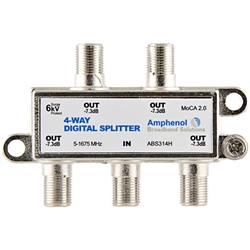In the room where the AT&T is, do you need to use the coax for any cable functions? If not, the solution is actually super simple--connect the motorola in that room and then in the attic, disconnect that particular coax feeding that room and connect the other motorola to that cable. This way, you have nothing on that cable except the motorolas and you should hit 1Gb no problem.
And this would be necessary for the bonded MoCA 2.0 adapters to hit their maximum throughput, up to 1 Gbps, achieving "TURBO" mode when no other MoCA nodes are present on the coax.
Relative throughputs for each MoCA spec:
- MoCA 1.1 w/ GigE ports can achieve up to 150 Mbps.
- Standard MoCA 2.0 up to 400 Mbps; 500 Mbps TURBO
- Bonded MoCA 2.0 up to 800 Mbps; 1000 Mbps TURBO
- MoCA 2.5 w/ GigE ports up to 1000 Mbps
Given the above, only the goCoax MoCA 2.5 adapters would likely be capable of hitting your required 1 Gbps requirement in a setup with 3+ MoCA devices on the same coax plant (i.e. precluding TURBO mode for MoCA 2.0).
Oh my. I don't think you're going to have much luck with 2 moca networks on the same coax. It doesn't work well with powerline technology and I don't think it will with moca either.
It's theoretically possible; whether the specific hardware (and its software) allows for the supported configuration is another question. Per pg. 6 of the
MoCA 2.0 specs doc (and
pg. 8 from the 2.5 specs):
The MoCA 2.0 frequency plan defines, within the new extended band D, two sub-bands for independent network operation. These sub-bands comprise the D-low and D-high, as follows:
Sub-band D-Low (DL): 1125 to 1225 MHz edge to edge (100 MHz wide)
Sub-band D-High (DH): 1350 to 1675 MHz edge to edge (325 MHz wide)
Guard-band between sub-bands: 1225 to 1350 MHz (125 MHz wide
Now, if you're connecting both xfinity and att to the same lan, there may be dual dhcp server issues unless xfinity is not using one, and that can also be an issue, but would appear as stuff working 100% and then just not working at all. Hope this helps!
Right, the Motorola/ATT and Xfinity MoCA networks must not be mixed, any more than you'd connect an Ethernet cable between the ATT and Xfinity gateways. Short of dedicated coax for the "ATT" MoCA network, you'd need to get the Xfinity MoCA network operating in Band D-Low and the ATT MoCA network operating at Band D-High -- and privacy on the ATT MoCA network would be a good idea.
So, can the X1 devices be configured to only operate at Band D-Low? Then, if so, can the MM1000, ECB6200 or goCoax adapters be configured to strictly operate at Band D-High, to functionally isolate the ATT MoCA network from the Comcast network? Your adapter's vendor should be capable of assisting with this setup, or needs to be ... given Comcast is the largest cable provider in the country.
Reading the
MoCA 2.5 specs, I'm not sure how this dual network setup would be affected were you to use the goCoax adapters. One would hope their backward compatibility would allow for dual operation, if reducing their maximum throughput to that of bonded MoCA 2.0.
Also, the dual network operation possibility would be affected if your Xfinity Internet connection is DOCSIS 3.1 and using frequencies above 1 GHz, consuming the space that would otherwise be dedicated to the MoCA D-Low sub-band.



